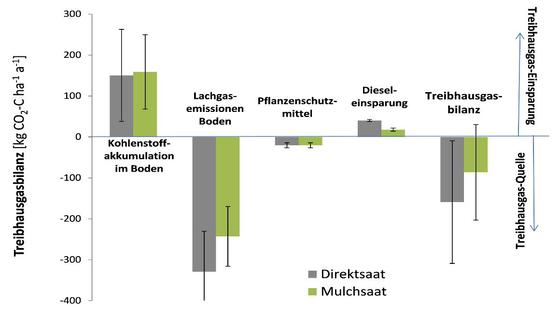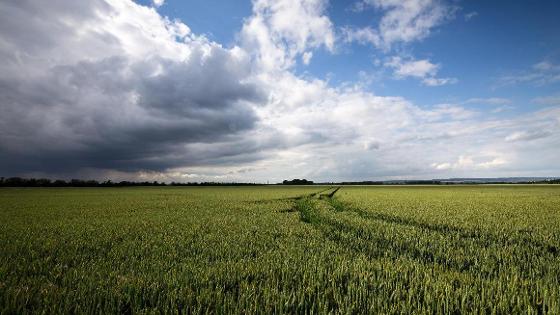Protein Crop Strategy
Expanding crop rotations in Germany and Europe to include more plants, in particular legumes (known as pulses), is an important part of making agriculture more sustainable.
In the Coalition Agreement for the 19th legislative term, the coalition parties stated that it would make the cultivation of legumes more appealing by further developing the Protein Crop Strategy.
The BMEL's Protein Crop Strategy is aimed at reducing competitive disadvantages of domestic protein crops (legumes such as broad beans, field peas, lupin species, clover species, alfalfa and vetch), closing gaps in research, and testing and implementing the necessary measures in practice – while taking international conditions into account.
A distinctive characteristic of legumes is that their roots establish a symbiotic relationship with bacteria (rhizobia).
These bacteria have the ability to bind nitrogen from the air which can then be used either by the legumes to form proteins or by succeeding crops as a plant nutrient. They have a positive impact on the environment.
For 2021, the German budget has earmarked EUR 4.8 million for the Protein Crop Strategy.
Aims of the Protein Crop Strategy
The Protein Crop Strategy mainly pursues the following objectives:
- improving ecosystem services and resource conservation (improving environmental protection and climate change mitigation, improving biodiversity in agricultural landscapes, reducing mineral nitrogen fertilisation, improving soil fertility);
- strengthening regional value chains;
- increasing the protein supply from domestic products and improving the protein supply through non-GMO protein carriers (the cultivation of genetically modified legume varieties is not permitted in Germany).
The strategy contains a raft of measures to encourage farmers to cultivate and use legumes in addition to cereals and oilseeds. The reform of the Common Agricultural Policy (CAP) in 2013 introduced new and more favourable conditions for the cultivation of legumes, and this is being continued in the new CAP from 2023 onwards. A number of other European and national instruments are also being used, such as the provision of support funds to promote suitable research projects. A central role is played by:
- research into legumes;
- projects focusing on demonstrating opportunities along the entire value chain from cultivation to use; and
- CAP measures, in particular for land-management methods conducive to climate stewardship and environmental protection from the 1st pillar and agri-environment-climate measures from the 2nd pillar
The focus is on both conventional and organic farming.
Legumes play a key role in organic farming as protein feed. The sixth package of measures in the Strategy for the Future of Organic Farming therefore established a pilot demonstration network on expanding and improving the cultivation and use of fine-seeded legumes for feeding ruminants and monogastrics.
Environmental impact of legumes
Increased cultivation of legumes extends the range of crop species and reduces the intensity of crop rotations. This can reduce the occurrence of harmful organisms and improve the efficiency of weed control measures through alternating between first-season and secondary-season crops and between leaf and cereal crops. Extended crop rotations contribute to integrated plant protection and a reduced risk of the development of resistance to pesticides. This can result in a reduced use of plant protection products and, consequently, can reduce the negative impact of these products on biological diversity. In addition, flowering legumes offer an excellent source of food for nectar-collecting, pollinating insects.
By reducing the use of mineral nitrogen fertilisers, the cultivation of legumes can also contribute to reducing the CO2 emissions arising from the production of these fertilisers. This means that increasing the quantity of legumes under cultivation makes an important contribution to climate change mitigation, the conservation and sustainable use of biological diversity and consequently to the diversity of agricultural ecosystems.
Agricultural policy measures: EU funding
The funding made available under the CAP supports both farmers and rural regions within the EU. The new funding period begins in 2023. The member states are required to develop strategic plans for pillars I and II. In future, the economic prospects of farmers and of rural regions will be more closely linked to environmental and climate protection.
EU funding continues to be divided across two pillars:
- Direct payments to farmers are a major element of the CAP, forming pillar I. The introduction of eco schemes as a key component of the new green architecture has created incentives for farmers to participate in environmental and climate protection measures, making production even more sustainable.
- The second pillar comprises specific funding programmes for sustainable and environmentally sound farming and rural development.
Promotion of research and development projects
The funding of projects aims to promote the cultivation and use of legumes on the basis of existing research results. To this end, model demonstration networks will be established to improve extension services and knowledge transfer. This will be accompanied by research and development projects initiated to improve existing methods, generate innovation and, above all, promote the breeding of high-yield varieties.
Project management, i.e. the responsibility for implementing and coordinating the measures, has been transferred to the Federal Office for Agriculture and Food. An office has been set up at the Federal Office for this purpose.
Cultivation of legumes in Germany
Agricultural holdings in Germany increasingly rely on domestic legumes (pulses). This trend towards expanding the cultivation area has continued in 2021: almost 245,000 hectares of grain legumes were cultivated this year. This is an increase of more than nine per cent compared to the previous year.
Since 2010, the cultivation area for grain legumes has more than doubled in Germany. Over the same period of time, the area used for the cultivation of whole-plant legumes was expanded by more than 36 per cent.
Before the Protein Crop Strategy, which was published in December 2012, took full effect, legume cultivation had steadily decreased in Germany due to its low competitiveness. There were many reasons for this,
- including the greater physical and monetary yield of competing crops such as grains, maize, sugar-beet and rapeseed, the greater complexity of legume cultivation, the greater fluctuation in legume yields, a lack of marketing and processing opportunities, and the specific parameters of the agricultural policy framework.
- As a result, knowledge of production techniques was lost, progress in breeding new varieties was slow and there was a drop in the range of suitable and effective plant protection measures and specific preparation and processing methods that were available.
- This resulted in a negative spiral that saw domestic protein crops becoming less and less competitive.
In view of this, the BMEL's Protein Crop Strategy helps crop rotations with legumes perform just as well monetarily in the medium term as crop rotations without legumes, where only grains, maize, sugar-beet or rapeseed are cultivated. In addition to the economic instruments for determining the intra-farm competitiveness of individual crops (performance without direct costs or labour costs, contribution margin), this must for example also take into account the effects legumes have on follower crops (e.g. reducing the use of mineral nitrogen fertilisers) or the phytosanitary effects (e.g. reduction of plant protection products).
The land-use survey published the following figures regarding the area of land under the various pulses referred to in the diagram:
| Field crops | 2010 | 2011 | 2012 | 2013 | 2014 | 2015 | 2016 | 2017 | 2018 | 2019 | 2020 | 2021 |
|---|---|---|---|---|---|---|---|---|---|---|---|---|
Source: Federal Statistical Office, BMEL (723) 1) Statistically recorded since 2016 - 2) excluding soya beans 3) data not yet available | ||||||||||||
| Broad beans | 16,3 | 17,3 | 15,8 | 16,5 | 20,5 | 37,6 | 38,8 | 46,4 | 55,3 | 49,2 | 58,7 | 57,7 |
| Peas (excluding fresh peas) | 57,2 | 55,8 | 44,8 | 37,9 | 41,7 | 79,1 | 87,5 | 85,5 | 70,7 | 74,6 | 82,6 | 98,0 |
| Sweet lupins | 24,0 | 21,5 | 17,9 | 17,4 | 21,4 | 29,8 | 28,6 | 29,0 | 23,4 | 21,0 | 22,3 | 28,9 |
| Soya1) | - | - | - | - | - | - | 15,8 | 19,1 | 24,1 | 28,9 | 33,8 | 34,3 |
| Other2) | 3,2 | 2,9 | 3,6 | 2,9 | 8,8 | 13,9 | 16,4 | 17,2 | 18,2 | 22,0 | 26,5 | 3) |
| Total | 100,7 | 97,5 | 82,1 | 74,7 | 92,4 | 160,4 | 187,1 | 197,3 | 191,7 | 195,7 | 223,9 | 244,9 |
The increase in cultivating legumes on arable land confirms the BMEL in its assessment that CAP reform measures in particular (cultivation possible as EFAs, AECM support scheme) and the measures to promote research and development projects have succeeded in making arable farming in Germany more sustainable.
European Soya Declaration
On 17 July 2017, 14 EU Ministers of Agriculture (Germany, Hungary, Austria, France, the Netherlands, Italy, Poland, Croatia, Romania, Slovenia, Slovakia, Finland, Greece, Luxembourg) signed the European Soya Declaration. They advocate sustainable and certified production, processing and marketing of protein crops in Europe, particularly soya. The Declaration lists measures to reach this objective and thus contribute to more sustainability in European agriculture, especially by promoting the locally adapted cultivation of legumes, fostering optimised feeding, informing consumers about the inclusion of plant-based protein sources in diets, and enhancing support for import certifications. At the fringes of the 2018 International Green Week, the Ministers of Agriculture from four Eastern European states (Moldova, Montenegro, Kosovo and Macedonia) acceded to the Declaration, Switzerland joined in 2019.
Dialogue forum on making protein feed more sustainable
The dialogue forum on making protein feed more sustainable is an established platform, where stakeholders along the value chain consider and discuss solutions for the use of more sustainable protein feed in Germany in an informal setting. The members of this forum comprise 65 companies, associations, scientific institutions and authorities from the areas of agriculture, nature conservation, food and feed production and trade. A steering committee consisting of the most important stakeholder bodies (producers, processors/trade, retail, nature conservation groups) advises and supports the forum.
The consultations resulted in a joint position paper that outlined 8 ideas. In the paper, the forum affirmed its commitment to raising the proportion of legumes in cultivation and feed and to boosting the competitiveness of legumes. It also advocates using only certified sustainable soya in the future. In doing so, the dialogue forum and its members have sent a strong message that the stakeholders in Germany are assuming responsibility in the global supply chains and want to improve social, economic and environmental conditions along the entire protein feed value chain.
World Pulses Day on 10 February
On 20 December 2018, the General Assembly of the United Nations agreed that 10 February should become the World Pulses Day. This acknowledges the key role pulses play for a healthy and balanced diet and the environmental benefits for sustainable farming. The World Pulses Day is intended to follow-up on the large amount of attention that was paid to the International Year of Pulses (2016).
You can find the FAO statement here and the corresponding resolution (A/RE/73/251) is accessible under http://www.un.org/en/ga/search/view_doc.asp?symbol=A/RES/73/251.













